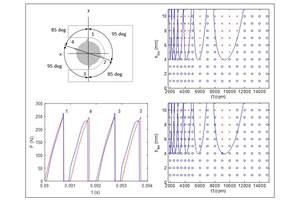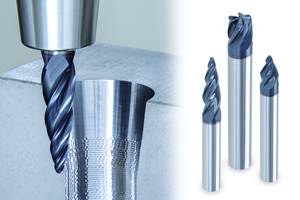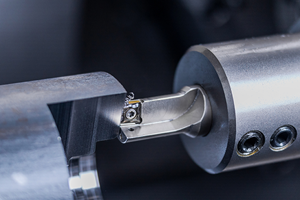Aerospace On A Diet
The difficulty of close tolerance finishing in both high temperature alloys and titanium is particularly real in the Aerospace industry, where thinwall construction is becoming more common. Read how an insert gave this shop an edge.
The demand for improved payload capacity and fuel economy for jet engines keeps aerospace engineers scrambling. Fortunately, the strength of today's super alloys affords design engineers more flexibility. One design element that has proven effective is weight reduction by decreasing the component cross sections to thin walls. However, thinwall sections increase the difficulty of machining operations because even the slightest tool pressure or part deflection can become a major problem. Tool pressure on thin walls can lead to inherent part distortion and loss of tolerances while vibration of the thin wall can cause the insert to be chipped, thereby reducing the quality of the surface finish. The associated costs of frequently indexing inserts, reworking or even scrapping parts are unacceptable.
Middleton Aerospace (Middleton, Massachusetts) found itself on the aerospace diet when it won a contract for the production of a titanium retainer/seal for a jet engine compressor. Steve Diantzikis, project engineer at Middleton Aerospace, took on the task and realized that the thinwall section would be a problem to machine.
Mr. Diantzikis first designed a fixture to clamp on the bore and OD to secure and stabilize the part to permit turning of the 0.045-inch thinwall section. The part went into production despite surface finish problems, which continued to plague the operation. The tool pressure induced part deflection, leading to inconsistent wall thickness and balance problems. Additionally, unrelieved stress during machining caused the part to warp after removal from the fixture. Middleton's customer insisted that the dimensions and tolerances of the thinwall section were to be met while holding the part unconstrained during machining. Therefore, the OD clamps were eliminated and the fun began. Everything Mr. Diantzikis tried contributed to chatter in the thinwall section of the part that then chipped the inserts, causing surface finish quality to be out of tolerance.
Concurrently, Greenleaf Corporation (Saegertown, Pennsylvania) had been searching for a place to test its new insert with a chipbreaker developed for finish machining in the aerospace industry. Greenleaf had recognized the difficulty of close tolerance finishing in both high temperature alloys and titanium. Greenleaf developed a precision ground insert with a high positive, molded chipbreaker. At the suggestion of the Greenleaf service engineer, Middleton decided to initiate a test on the thinwalled part. The new TurboForm (TF) insert cut so freely that vibration and tool deflection were virtually eliminated. Additionally, the 'orange peel' finish, common to titanium finishes, all but disappeared. Tool life was extended to the point where each edge now completes a finish cut and goes on to perform the roughing operation on the next part.
In an effort to further prove the new chipform, the complex contours on a jet engine spool provided yet another set of challenges. A high surface finish quality on the OD of this titanium part was required for ultrasonic inspection. Greenleaf customengineered tooling along with the new TF insert proved capable of maintaining the required surface finish over the entire length of the OD and ID contours. Riding the success of these applications, Middleton engineers looked for other projects where the new chipform could work. Project engineer Jim Whitney had two candidates. The first was a jet engine, lowpressure turbine, Waspaloy shaft approximately 3 feet in length. The combination of length and thinwall section made it difficult to hold tolerances. Contributing to the degree of difficulty was the extended cantilevering of the boring tools making the toolholding less rigid. The new chipform allowed a continuous cut to be made with minimum tool pressure enabling tolerances to be held over the required length.
The second project was a jet engine, lowpressure turbine, Inconel 718 drive cone. Outofround conditions accounted for a 10 percent rejection rate at the balancing operation. Often parts, which passed the initial balance inspection, would still contribute to balance problems at final engine assembly. The expense of engine tear down and reassembly was unacceptable. Whitney had tried an endless selection of insert geometries with little luck. It turned out to be a good application for the TurboForm insert. The insert performed well enough that wall thickness is now maintained to within 0.0015inch over the entire length of the part, and the balance rejection rate fell to zero.
Middleton Aerospace recently opened a facility dedicated to shaft manufacturing. One of the problems encountered in machining thinwalled shafts from solid bar is the 'oil canning' or buckling of the shafts. Oil canning of thinwalled shafts occurs when excessive tool pressures are applied and caused by the tool not cutting freely. The use of bladders (an internal mechanism to exert outward force), filling the ID with sand and other tactics have been used to keep the thin walls from collapsing. Applying the TurboForm insert, Middleton implemented the first production run of a 32inch long shaft machined between centers without the use of internal force devices. Made from AM355 material, the shaft had an average wall thickness of 0.100inch that the TurboForm insert maintained to 0.001 to 0.0015inch maximum variation.
Related Content
The Impact of Cutting Teeth Spacing on Machining Stability
Many cutter designs are available, and variable teeth spacing (or variable pitch) cutters can be used to influence milling stability. Let’s discuss why teeth spacing affects stability.
Read MoreTungaloy Expands Line of Barrel-Shaped End Mills
The new SolidMeister barrel end mills are efficient tools for complex 3D-surfacing operations used in mold making, orthopedic implants and the machining of other freeform surfaces.
Read MoreCeratizit's Updated Tooling Solutions Improve Machining Performance
The company has upgraded its EcoCut indexable inserts lineup, as well as introduced two new toolholding and workholding solutions.
Read MoreFive-Axis Changes Weldments Into Monolithic One-Piece Parts
Moving from welding to five-axis machining enabled Barbco to redesign its weldments as monolithic one-piece parts with improved strength and repeatability.
Read MoreRead Next
3 Mistakes That Cause CNC Programs to Fail
Despite enhancements to manufacturing technology, there are still issues today that can cause programs to fail. These failures can cause lost time, scrapped parts, damaged machines and even injured operators.
Read MoreThe Cut Scene: The Finer Details of Large-Format Machining
Small details and features can have an outsized impact on large parts, such as Barbco’s collapsible utility drill head.
Read More










.png;maxWidth=300;quality=90)













